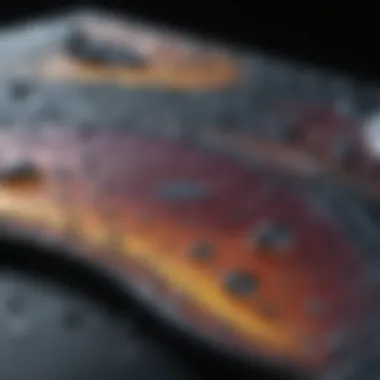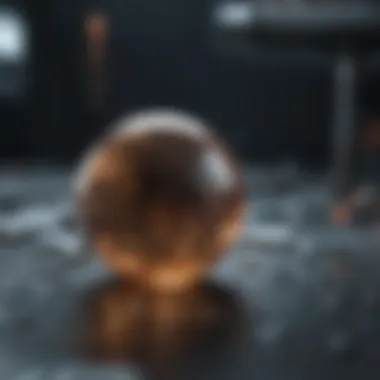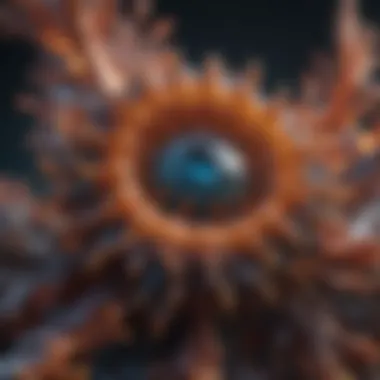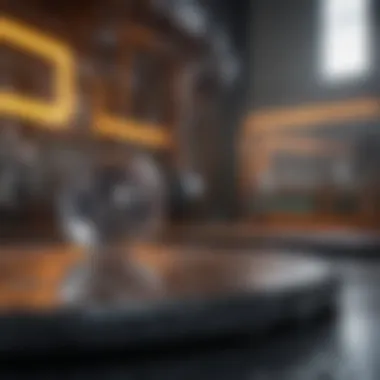Exploring Surface Generation: Techniques and Applications


Intro
Surface generation is a crucial aspect that connects various fields through its mathematical and computational foundations. Understanding how surfaces are constructed can provide insights into more complex structures and their real-world applications. This article delves into different techniques, ranging from basic mesh creation to intricate fractal designs. It also emphasizes the relevance of these methods across various disciplines such as computer graphics, engineering, and biology.
The exploration of surface generation expands beyond mere academic theory. This topic has implications for designing better models in simulations, creating realistic graphics, and understanding biological structures. By employing algorithms intertwined with geometric principles, researchers and professionals can achieve remarkable results in their respective fields. As we progress through this narrative, a clear view of the significant techniques, their applications, and the potential future directions for research will unfold.
Key Findings
- Summary of the main results
Surface generation techniques provide diverse approaches to create and analyze structures. Key methods include: - Significance of findings within the scientific community
The advancements in surface generation have led to improved accuracy in simulations within engineering and enhanced visual realism in computer graphics. Understanding complex surfaces is vital for various scientific inquiries, particularly in fields that rely on accurate modeling and data representation.
- Mesh generation using triangulation.
- Procedural generation based on algorithms.
- Fractal interpolation for simulating natural phenomena.
Techniques in Surface Generation
Different techniques highlight the flexibility and depth of surface generation. Among these techniques are:
- Polygon Meshes: This technique uses polygons to create a network that represents surfaces. Typically, triangles are the favored shape due to their simplicity and ease of computation.
- Subdivision Surfaces: This technique refines polygon meshes through iterative processes, leading to smoother surfaces. Artists often use subdivision methods in computer graphics for character modeling.
- NURBS (Non-Uniform Rational B-Splines): NURBS represent curves and surfaces with great precision. They are widely used in CAD applications due to their flexibility in adjusting surface shapes easily.
- Fractal Surfaces: These are generated through iterative mathematical functions. Fractal surfaces can depict natural landscapes and complex biological structures, showing self-similarity at different scales.
Implications of the Research
- Applications of findings in real-world scenarios:
Research in surface generation techniques has led to various practical applications: - Potential impact on future research directions:
The ongoing development of surface generation techniques promises innovative approaches in numerous disciplines. Future work may include improvement of algorithms for speed and efficiency, expanding applications in virtual reality, and exploring new materials in manufacturing.
- In computer graphics, enhanced realism in animations and game design.
- In engineering, simulations that require accurate depictions of physical properties.
- In biology, modeling intricate structures such as vascular systems or neural networks.
"The intersection of geometry and algorithms continues to redefine the possibilities in surface generation."
Overall, the techniques of surface generation offer a wealth of opportunities and insights that can significantly impact various fields. As we venture further into the discussion, understanding these techniques will reveal their intricate details and wide-ranging applications.
Preamble to Surface Generation
Surface generation is a complex yet vital aspect of numerous scientific and technological fields. This introductory section aims to illuminate the relevance of surface generation, providing a fundamental understanding that sets the stage for deeper exploration. Comprehending surface generation methods is essential, not just for technical practitioners, but for a broad audience invested in the future of design, engineering, and computational studies.
Definition and Importance
Surface generation refers to the process of creating geometric representations of surfaces using mathematical algorithms and computational methods. This technique is essential in modeling, simulation, and animation across various domains like computer graphics, engineering, and scientific visualization. The importance of this topic lies in its ability to enhance both efficiency and accuracy in representing complex forms.
Studying surface generation enables practitioners to leverage advanced algorithms that produce high-quality surface models. By understanding the mathematical underpinnings, one can tailor the algorithms to meet specific needs and optimize performance. Furthermore, it opens pathways for innovation, allowing for the creation of more realistic and intricate surfaces, an aspect crucial in applications such as virtual reality, product design, and architectural modeling.
Historical Overview
The evolution of surface generation techniques mirrors advances in technology and mathematical thought. Early attempts at surface modeling were rudimentary and could only handle simple shapes. Emerging from the origins of computer-aided design (CAD) in the 1960s and 1970s, surface generation began to gain traction with the development of more sophisticated algorithms and computing power.
Over time, developments like Bézier surfaces in the 1970s allowed for smoother and more controllable modeling environments. The adoption of NURBS (Non-Uniform Rational B-Splines) revolutionized the field, providing a powerful way to represent both standard geometric shapes and complex organic forms. As computational capabilities surged into the 21st century, researchers and developers were able to explore fractal geometries and procedural generation methods, pushing the boundaries of traditional surface modeling.
Mathematics Behind Surface Generation
Mathematics forms the backbone of surface generation techniques. It provides the framework for the algorithms that create and manipulate surfaces. Understanding the mathematical principles involved is crucial. They guide how we represent shapes, model surfaces, and ultimately, how we visualize them in various applications.
In surface generation, several mathematical concepts are prevalent. These include differential geometry, algebraic geometry, and numerical analysis. Each plays its role in defining how curves and surfaces interact in a virtual or physical space. The use of mathematics in this context allows for precision and efficiency. Without it, the art of surface generation would lack depth and might lead to inaccuracies in representation.
Geometric Foundations
Geometric foundations are essential when discussing surface generation. They provide a way to understand how geometric entities are defined, manipulated, and understood in both abstract and practical ways. At a basic level, geometry helps in the visualisation of surfaces and their properties, such as curvature and continuity.


Key elements of geometric foundations include points, lines, and planes, which combine to form more complex structures. Additionally, concepts like Bézier curves and B-splines play a significant role in defining smooth surfaces. These basic geometric concepts contribute to the creation of more sophisticated models used in computer graphics, engineering, and other fields.
Algorithms and Computational Approaches
Algorithms drive the practical application of mathematics in surface generation. The computational approaches employed can vary widely, but they generally aim to achieve efficiency and accuracy in surface representation. Understanding these algorithms allows researchers and practitioners to choose appropriate techniques based on their specific needs.
Subdivision Surfaces
Subdivision surfaces are a technique used to create smooth surfaces from a coarse mesh. They are notable for their iterative refinement process. This approach allows a rough model to become increasingly detailed and smooth while preserving the original shape's essential features. The key characteristic of subdivision surfaces is their ability to produce high-quality results with relatively simple input data. They are a popular choice because they work well in both 3D modeling and animation.
One unique feature of subdivision surfaces is their ability to handle irregular meshes gracefully. However, there are drawbacks. The process can be computationally intense, especially with complex models. Despite this, their advantages often outweigh the disadvantages in many applications, providing smooth and visually appealing results.
Parametric Surfaces
Parametric surfaces define surfaces using parameterized equations. This method gives flexibility in creating complex shapes. A significant benefit of parametric surfaces is their ability to represent intricate details easily by adjusting the parameters. This characteristic makes them a favorable choice in computer-aided design and animation.
A unique feature of parametric surfaces is their adaptability. They can easily slip from simple to complicated forms by altering the parametric equations. However, they also have limits, especially when dealing with sharp corners or discontinuities. Despite this limitation, parametric surfaces remain a powerful tool in the surface generation toolkit.
Implicit Surfaces
Implicit surfaces are defined by a function that represents a shape as the set of points that satisfy a particular equation. This approach allows for significant flexibility and creativity in surface generation. The key characteristic here is that implicit surfaces can define complex shapes without having to explicitly formulate their outline.
A notable advantage of implicit surfaces is that they can easily handle topology changes, such as merging or splitting. However, they can be less intuitive compared to other surface representation methods. While they offer a robust way to define surfaces, the computational complexity can increase significantly when processing intricate forms. Nevertheless, implicit surfaces present unique opportunities for researchers and artists in various fields.
Techniques in Surface Generation
Surface generation is a critical area in computer graphics, engineering, and various scientific fields. Its various methods offer flexibility and precision in modeling complex surfaces. These techniques are not mere technicalities but are foundational processes that underlie advanced applications. They facilitate the creation of realistic models, allowing designers and engineers to implement visually appealing and functional structures. The significance of understanding these techniques cannot be overstated, as they dictate the efficiency and effectiveness of the final outcome.
Mesh Generation Techniques
Mesh generation refers to the process of creating a network of vertices, edges, and faces to represent a given surface. This is a crucial element in modeling because it dictates the detail and quality of the representation.
Triangular Mesh Generation
Triangular mesh generation is a well-known technique widely used in surface representation. One notable aspect of this method is its ability to represent complex geometries with high precision. The key characteristic of triangular meshes is their simplistic structure; each facet consists of just three vertices. This simplicity allows for easier computation in physical simulations and rendering tasks.
Additionally, triangular mesh generation offers excellent adaptability. It can effectively tessellate surfaces of varying complexities. This adaptability contributes significantly to its popularity in fields such as computer graphics and engineering, where modeling intricate shapes is crucial. Nevertheless, triangular meshes can lead to long processing times if not optimized properly, especially for high-resolution models.
Quadrilateral Mesh Generation
Quadrilateral mesh generation serves as another fundamental approach in surface modeling. Its defining aspect is the use of four-sided polygons. This characteristic can lead to reduced computational time compared to triangular meshes when applying specific algorithms or rendering techniques. Quadrilateral meshes tend to produce smoother surfaces and maintain a more structured topology, leading to better quality in simulations.
The unique feature of quadrilateral mesh generation lies in its ability to provide cleaner geometries, especially in applications such as CAD modeling. However, quadrilateral meshes can be more difficult to implement in certain cases, particularly for non-planar surfaces.
Fractal Surface Generation
Fractal surface generation presents a distinctive way to create natural-looking terrains and organic shapes. This technique takes advantage of mathematical patterns, thereby producing visually complex structures from relatively simple algorithms.
Perlin Noise
Perlin noise is a coherent noise function frequently utilized in the creation of textures and landscapes. Its primary contribution to surface generation lies in its ability to mimic natural randomness efficiently. The key feature that stands out about Perlin noise is that it generates continuous and smooth gradients, making it ideal for modeling elements like clouds, terrains, and other organic shapes.
As a result, it provides a beneficial way to introduce complexity without overwhelming computational resources. One disadvantage is that it may require additional tuning to achieve the desired visual effects.
Midpoint Displacement


Midpoint displacement is another method employed for terrain generation. This technique expands on basic displacement strategies to create jagged and irregular surfaces that approximate natural elevations. A crucial characteristic of midpoint displacement is its recursive nature, allowing for the generation of details on various scales.
The strength of this method is its relative simplicity and the ability to produce convincingly complex terrains quickly. However, it can lead to artifacts in some cases, particularly if the parameters are not set correctly, which could detract from the realism of generated surfaces.
Procedural Generation Methods
Procedural generation methods provide a dynamic way to create complex surfaces and environments algorithmically. This approach minimizes manual detailing, allowing for greater efficiency and variance within the generated content. By using set rules and randomness, one can produce infinite variations of a surface without repeating the same patterns.
Applications of procedural generation are extensive, covering fields from game design to simulations. It presents both opportunities and challenges, as the balance between realism and complexity must be managed carefully. These methods often rely on a strong mathematical foundation. As a result, they blend the technical aspects of surface generation seamlessly with creative design, opening new avenues for exploration.
Applications of Surface Generation
The applications of surface generation are pivotal in diverse fields, impacting everything from design processes to scientific modeling. By effectively generating surfaces, professionals can create and manipulate complex shapes and forms essential in their disciplines. This section delves into major areas where surface generation plays a critical role, highlighting its advantages and intricacies.
Computer Graphics and Animation
In the realm of computer graphics, surface generation forms the backbone of visual content creation. This process allows artists and designers to construct realistic models and animations used in gaming, films, and virtual reality applications.
Surface generation techniques enable the creation of detailed textures and surfaces, improving visual fidelity. High-resolution models are crafted using mesh generation methods, giving rise to intricate designs. Techniques like subdivision surfaces enhance the smoothness of models, making them look more lifelike.
Moreover, understanding various algorithms aids in optimizing performance during animations, reducing render time. The ability to generate convincing surfaces builds immersion in digital environments. Thus, surface generation is indispensable for engaging visual storytelling.
Engineering and Manufacturing
Surface generation's influence extends into the engineering and manufacturing sectors. Here, precision and accuracy are critical. Engineers leverage surface generation techniques in various applications, such as Computer-Aided Design (CAD) and Finite Element Analysis.
CAD Modeling
CAD modeling is a fundamental aspect of engineering design. It allows for the precise modeling of components and assemblies using advanced surface generation techniques. The key characteristic of CAD modeling is its ability to represent 3D objects accurately with a focus on functionality and manufacturability.
CAD software like AutoCAD and SolidWorks provides users with tools to create complex geometries. These tools enable engineers to visualize and iterate on designs quickly. The benefit of this approach is a streamlined design process that reduces errors and enhances communication among project teams. A distinct feature of CAD modeling is parametric design, allowing for modifications to be applied easily without starting from scratch. However, it may require a steep learning curve for beginners.
Finite Element Analysis
Finite Element Analysis (FEA) is another critical application within the engineering field that relies heavily on surface generation. FEA approximates solutions to complex structural and thermal problems by breaking down a large problem into smaller, manageable parts, known as finite elements.
The primary characteristic of FEA is its computational strength, enabling engineers to predict how designs will react under various conditions. This predictive nature of FEA makes it a popular choice for validating designs before physical prototypes are built. Additionally, the unique feature of mesh generation from solid models allows for detailed analysis and tailored optimization of structures. However, FEA demands substantial computational resources and expertise, which can present challenges for some organizations.
Biological and Environmental Models
Surface generation also finds relevance in biological and environmental modeling. Researchers use surface generation tools to accurately depict structures such as proteins, cells, and geological formations.
By utilizing fractal generation techniques, scientists can model complex natural phenomena, leading to insights in biology and environmental science. These models assist in understanding intricate natural processes and phenomena. Surface generation thus emerges as an effective method for translating multi-dimensional biological data into comprehensible representations.
"Effective surface generation bridges the gap between theory and practical application across numerous fields, enhancing our ability to analyze and design."
Challenges in Surface Generation
Understanding the challenges in surface generation is crucial for advancing the field. While developing new techniques, researchers and practitioners often encounter several obstacles that can complicate their efforts. Recognizing these problems not only helps in refining methods but also in informing the design of applications that rely on robust surface generation. Without addressing these challenges, the potential of surface generation techniques may remain unfulfilled. The two primary challenges explored here are computational complexity and the balance between realism and efficiency.
Computational Complexity
Computational complexity is a significant consideration in surface generation. With intricate algorithms at play, the execution time and resource usage can escalate rapidly as complexity increases. Factors that contribute to this complexity include the number of vertices in a mesh, the algorithms chosen, and the resolution of the surfaces being generated.


The time needed to create surfaces can vary based on the specifics of the model. For example, applying algorithms such as the Marching Cubes for isosurface extraction requires substantial computation when scaling to larger datasets. Using computational resources efficiently can lead to faster surface generation without sacrificing quality.
Here are some notable strategies to mitigate computational complexity:
- Optimizing Algorithms: Employing more efficient algorithms can reduce processing times significantly.
- Simplicity in Design: Simplifying models can decrease the computational burden associated with their generation.
- Parallel Processing: Leveraging multi-threading or distributed computing can help to speed up complex calculations.
"Efficiency in computation can be the difference between a workable model and an inaccessible one."
The implications of high computational complexity are broad. In fields such as real-time graphics or simulations, delays can make it impractical to use certain surface generation methods. Therefore, balancing detail and the cost of computation is essential for practical applications.
Realism vs. Efficiency
Another critical challenge in surface generation is finding the balance between realism and efficiency. On one hand, high-fidelity surfaces offer a level of detail that enhances visual appeal and accuracy in simulations. On the other hand, this increased realism often comes with heightened computational demands that can slow down processing times or require more powerful hardware.
In many use cases, especially in animation and virtual reality, users expect realistic representations. However, achieving this realism without sacrificing performance is not always possible. Here are considerations that affect this balance:
- LOD (Level of Detail): Employing different levels of detail based on viewer distance can optimize performance while maintaining a realistic appearance.
- Texture Mapping: Instead of generating highly detailed surfaces, strategically using texture maps can simulate detail efficiently.
- Adaptive Techniques: Algorithms that adjust fidelity on-the-fly can ensure performance remains adequate without compromising too much on realism.
Finding the right balance requires an understanding of the context in which the surface will be used. For instance, in engineering simulations, a high degree of accuracy often takes precedence over speed. Conversely, in gaming, real-time rendering capabilities are paramount.
Future Directions in Surface Generation Research
Future directions in surface generation research hold significant importance for advancing the field's potential. Technological innovations are evolving rapidly, and the integration of cutting-edge methods can enhance both accuracy and creativity in surface generation techniques. This section explores two prominent areas of research: emerging technologies and interdisciplinary collaboration. These themes are essential as they tackle the growing complexities within surface generation, assessing not just the technological aspects, but also the cooperative efforts needed across various disciplines.
Emerging Technologies
Machine Learning in Surface Generation
Machine learning is increasingly recognized for its potential in surface generation. This technique enables systems to learn from data, improving their efficiency and effectiveness in generating surfaces. A key characteristic of machine learning in this context is its ability to predict surface properties based on prior examples. This attribute makes it a popular choice among researchers and professionals alike.
One unique feature of machine learning is its capacity to handle large datasets, which is crucial for generating complex geometries that traditional methods struggle with. The advantages are evident; those involved in fields such as computer graphics and engineering benefit from enhanced precision and speed in producing high-quality surfaces. However, it also presents challenges, such as the need for substantial computational power and the potential for bias in training datasets. Despite these drawbacks, the overall benefits of machine learning in surface generation justify its growing popularity and application.
Real-time Processing
Real-time processing is another significant aspect of surface generation. It allows for immediate feedback and interaction when creating and modifying surfaces, which is crucial in areas such as gaming and virtual reality. The ability to generate surfaces in real time makes it a highly beneficial choice in the industry.
A unique feature of this method is its adaptability to user input. This leads to interactive applications where users can manipulate geometric surfaces while seeing the results instantaneously. The advantages of real-time processing include improved user experience and engagement. However, it also comes with its own set of challenges, such as ensuring that the quality of generated surfaces does not compromise due to performance demands.
Interdisciplinary Collaboration
Interdisciplinary collaboration is essential for fostering innovation in surface generation research. By combining expertise from various fields, including mathematics, computer science, and art, researchers can create more robust and versatile surface generation techniques. This collaboration leads to shared knowledge, which can improve methodologies and outcomes.
Such teamwork often enables exploration of new ideas and perspectives that might not surface in a more isolated environment. For instance, insights from biological modeling can inspire new algorithms for surface generation, leading to more organic forms. Ultimately, effective interdisciplinary collaboration can drive deeper exploration and pull multi-faceted solutions to the complex challenges present in the domain of surface generation.
Epilogue
The conclusion of this article serves to encapsulate the critical themes and insights gathered from the exploration of surface generation techniques and their applications. It is imperative to reflect on both the significance and repercussions of these techniques across various fields, fortifying our understanding of complex systems and enriching practical applications.
Summary of Findings
In reviewing the diverse methods of surface generation, several key findings have emerged:
- Techniques: Various techniques such as mesh generation, fractal generation, and procedural methods stehen at the forefront of surface generation. Each method offers unique advantages, shaped by its specific application context.
- Applications: Surface generation plays a pivotal role in numerous domains including computer graphics for creating realistic environments, engineering through CAD modeling, and biological modeling that fosters insights into complex organisms and ecosystems.
- Challenges: Despite its advancements, challenges such as computational complexity and balancing realism with efficiency continue to present obstacles that researchers must navigate.
All these factors converge to highlight the relevance of surface generation in contemporary science and technology. Understanding these intersections provides a foundational perspective for any future explorations within this expansive field.
Call for Further Research
As we contemplate the future of surface generation, it is essential to identify key areas where further research is warranted:
- Advanced Algorithms: There is a need for the development of more robust algorithms that can efficiently handle intricate surface generation tasks while minimizing computational overhead.
- Integration with AI: Exploring the integration of machine learning techniques into surface generation processes can enhance the efficiency and adaptability of these surfaces in real-time applications.
- Interdisciplinary Studies: Encouraging interdisciplinary research will enable a deeper understanding of how surface generation influences various fields, potentially leading to breakthroughs in technology and science.







